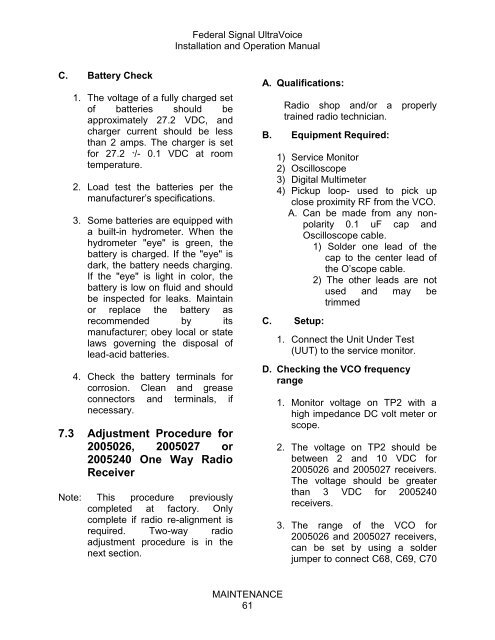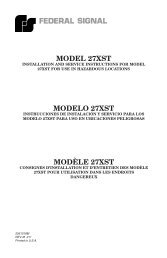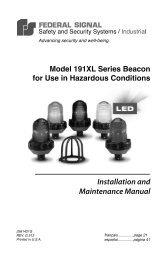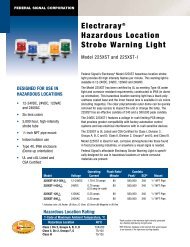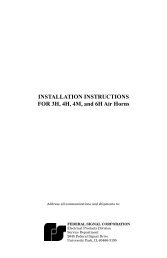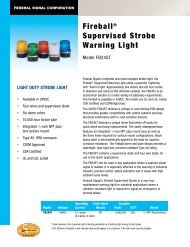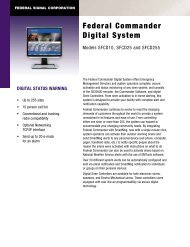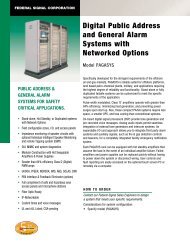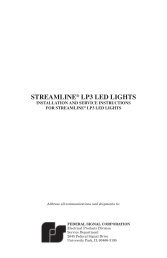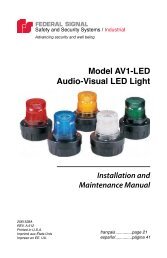UltraVoice Manual - Alerting & Notification
UltraVoice Manual - Alerting & Notification
UltraVoice Manual - Alerting & Notification
You also want an ePaper? Increase the reach of your titles
YUMPU automatically turns print PDFs into web optimized ePapers that Google loves.
C. Battery Check<br />
1. The voltage of a fully charged set<br />
of batteries should be<br />
approximately 27.2 VDC, and<br />
charger current should be less<br />
than 2 amps. The charger is set<br />
for 27.2 + /- 0.1 VDC at room<br />
temperature.<br />
2. Load test the batteries per the<br />
manufacturer‟s specifications.<br />
3. Some batteries are equipped with<br />
a built-in hydrometer. When the<br />
hydrometer "eye" is green, the<br />
battery is charged. If the "eye" is<br />
dark, the battery needs charging.<br />
If the "eye" is light in color, the<br />
battery is low on fluid and should<br />
be inspected for leaks. Maintain<br />
or replace the battery as<br />
recommended by its<br />
manufacturer; obey local or state<br />
laws governing the disposal of<br />
lead-acid batteries.<br />
4. Check the battery terminals for<br />
corrosion. Clean and grease<br />
connectors and terminals, if<br />
necessary.<br />
7.3 Adjustment Procedure for<br />
2005026, 2005027 or<br />
2005240 One Way Radio<br />
Receiver<br />
Note: This procedure previously<br />
completed at factory. Only<br />
complete if radio re-alignment is<br />
required. Two-way radio<br />
adjustment procedure is in the<br />
next section.<br />
Federal Signal <strong>UltraVoice</strong><br />
Installation and Operation <strong>Manual</strong><br />
MAINTENANCE<br />
61<br />
A. Qualifications:<br />
Radio shop and/or a properly<br />
trained radio technician.<br />
B. Equipment Required:<br />
1) Service Monitor<br />
2) Oscilloscope<br />
3) Digital Multimeter<br />
4) Pickup loop- used to pick up<br />
close proximity RF from the VCO.<br />
A. Can be made from any nonpolarity<br />
0.1 uF cap and<br />
Oscilloscope cable.<br />
1) Solder one lead of the<br />
cap to the center lead of<br />
the O‟scope cable.<br />
2) The other leads are not<br />
used and may be<br />
trimmed<br />
C. Setup:<br />
1. Connect the Unit Under Test<br />
(UUT) to the service monitor.<br />
D. Checking the VCO frequency<br />
range<br />
1. Monitor voltage on TP2 with a<br />
high impedance DC volt meter or<br />
scope.<br />
2. The voltage on TP2 should be<br />
between 2 and 10 VDC for<br />
2005026 and 2005027 receivers.<br />
The voltage should be greater<br />
than 3 VDC for 2005240<br />
receivers.<br />
3. The range of the VCO for<br />
2005026 and 2005027 receivers,<br />
can be set by using a solder<br />
jumper to connect C68, C69, C70


